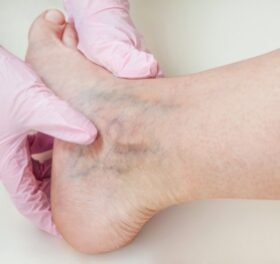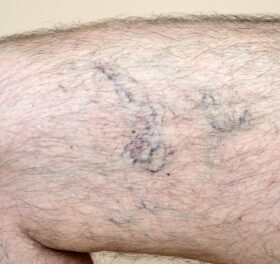If you’re reading this article, there’s a pretty strong chance that you have spider veins (or know someone with spider veins). Unless, of course, you enjoy reading about spider veins for entertainment. Spider veins are dense clusters of damaged blood vessels and broken capillaries that appear on the skin’s surface, usually resembling a mass of spider webs or tree branches. While they’re generally considered a simple cosmetic issue, they can also indicate underlying chronic venous insufficiency, a dangerous medical condition necessitating prompt treatment. These intricate, web-like veins can be unsightly and, for some, even painful.
But what’s the best treatment for spider veins? Can you treat spider veins by wearing compression stockings and lifestyle changes alone? Or do you need to undergo surgery? Spider veins can’t be treated with lifestyle changes alone, though they can be managed and controlled with compression stockings, and there’s no need for surgical treatments. Thanks to modern medicine, we can effectively treat spider veins using safe, in-office, minimally invasive treatments. And that’s precisely how we treat spider veins at Vein Treatment Clinic, the leading group of vein clinics in the United States.
Please schedule an appointment at your nearest Vein Treatment Clinic for an evaluation and treatment. Or continue reading to learn more about spider vein treatments.
What Are Spider Veins?
Spider veins, scientifically known as telangiectasia, are small, dilated blood vessels that appear close to the surface of the skin. They often resemble fine red or blue lines, forming a web-like pattern. These veins are most commonly found on the legs but can appear on other parts of the body as well. While they are generally not a medical emergency, they can cause discomfort, itching, burning, and aching in some individuals. In some cases, they’re also symptomatic of chronic venous insufficiency, a circulatory disorder wherein blood accumulates in the leg veins due to malfunctioning vein valves. Additionally, many people seek treatment for spider veins primarily for cosmetic reasons, as they can be unsightly and affect self-esteem.
When To Seek Treatment
Deciding when to seek treatment for your spider veins is a personal choice. Some individuals may choose to address them solely for cosmetic reasons, while others may opt for treatment due to discomfort or pain. And others must seek treatment if spider veins are also accompanied by signs and symptoms of chronic venous insufficiency, such as leg heaviness, frequent leg cramps, leg pain, restless leg syndrome, and varicose veins.
The following are the signs and symptoms of venous insufficiency:
- Swelling in the legs and ankles
- Aching or heaviness in the legs
- Varicose veins
- Skin discoloration or darkening
- Leg ulcers or sores
- Itching or burning sensations
- Restless leg syndrome
- Skin changes, such as thickening or inflammation
One of the first steps in addressing your spider veins is to consult with a vein specialist, and that’s where we come in. At Vein Treatment Clinic, our board-certified vein doctors are experts in diagnosing and treating spider veins and varicose veins. Our team is led by highly-skilled, board-certified, fellowship-trained vein doctors who take the time to run advanced diagnostic tests, identify the root cause of spider veins, and curate a personalized treatment plan.
Minimally Invasive Spider Vein Treatments
1. Sclerotherapy
Sclerotherapy is undoubtedly the most effective treatment for spider veins and small varicose veins. During this procedure, a special solution is injected directly into the affected veins. This solution irritates the lining of the veins, causing them to collapse and gradually fade from view. Sclerotherapy is known for its high success rate and minimal discomfort during the procedure.
2. Laser Treatment
Laser treatment uses focused laser light to target and heat the spider veins, causing them to fade away. Laser treatment is quick and virtually painless, making it a popular choice among patients. However, laser treatment can only address the most superficial veins, usually on the face and feet, and you need several sessions several weeks apart for results.
3. Wear Compression Stockings
While not a treatment in itself, compression stockings can help manage the symptoms of spider veins. These specially designed stockings apply gentle pressure to your legs, helping to improve blood flow and reduce discomfort. Your vein specialist may recommend wearing compression stockings in combination with other treatments.
4. Lifestyle Changes
In addition to medical treatments, certain lifestyle changes can also help prevent and manage spider veins. These include maintaining a healthy weight, staying physically active, avoiding prolonged periods of standing or sitting, and elevating your legs whenever possible. The following are lifestyle changes you can implement to manage spider veins:
- Engage in exercises that activate your leg muscles, such as yoga and running
- Elevate your legs above your heart’s level while sitting or lying down
- Avoid prolonged sitting or standing
- Maintain a healthy weight
- Wear compression stockings as recommended
- Stay hydrated and incorporate dietary fiber
- Avoid tight clothing
- Take breaks for leg movement during long periods of sitting
- Avoid crossing your legs for extended periods
5. Other Minimally Invasive Procedures
In some cases, larger veins may contribute to the development of spider veins. Our vein doctors may recommend advanced procedures such as endovenous laser ablation, radiofrequency ablation, VenaSeal, or ClariVein to treat underlying chronic venous insufficiency and varicose veins. If your spider veins are caused by vein disease, the only way to ensure long-lasting results is by treating the root cause, or else the spider veins will simply return.
6. Ambulatory Phlebectomy
For larger varicose veins, ambulatory phlebectomy may be recommended. Ambulatory phlebectomy involves making extremely small incisions on the skin’s surface and using hook-like devices to extract unwanted varicose veins. This procedure helps remove superficial varicose veins that are too large for sclerotherapy.
The Benefits of Minimally Invasive Treatments:
- Minimal Discomfort: Most patients experience minimal discomfort during and after minimally invasive procedures, allowing for a quicker return to daily activities.
- Short Recovery Time: Recovery time is significantly reduced compared to surgery, meaning you can get back to your normal routine sooner.
- Less Scarring: Minimally invasive procedures typically result in smaller incisions and less scarring than traditional surgery.
- High Success Rates: These treatments have a high success rate in effectively treating spider veins, and the results are even better than surgical treatments.
- Improved Aesthetics: Minimally invasive procedures are designed to improve the appearance of your legs, leaving you with smoother, clearer skin.
Aftercare & Recovery Guidelines:
- Follow Medical Advice: It’s crucial to follow all post-treatment instructions provided by your vein specialist. This may include wearing compression stockings, avoiding strenuous activities, and keeping the treated area clean.
- Stay Active: While you should avoid intense physical activities immediately after the procedure, light walking can help promote circulation and reduce the risk of complications.
- Watch for Complications: In extremely rare cases, you may experience complications like infections or allergic reactions. You must be vigilant for signs of infection, such as redness, pain, and swelling. If you notice these issues, please contact your vein doctor promptly.
- Maintain a Healthy Lifestyle: Continue to follow a healthy lifestyle with regular exercise and a balanced diet to support overall vein health.
Results & Expectations
The results of minimally invasive spider vein treatments are typically gradual. You may notice an improvement in the appearance of your legs within a few weeks to a few months, depending on the treatment method and the severity of your spider veins. Multiple sessions may be required for optimal results. While these procedures are highly effective in reducing the visibility of spider veins, complete elimination is not always possible. However, most patients experience a significant improvement in the appearance of their legs and a reduction in discomfort.
Frequently Asked Questions
Can dermatologists treat spider veins?
While dermatologists are experts in treating various skin conditions, including some cosmetic vein concerns, it’s advisable to consult with a board-certified vein specialist for spider veins. Vein specialists have specialized training and experience in diagnosing and treating vein-related issues, ensuring you receive the most appropriate care.
How can I prevent spider veins?
Maintaining a healthy weight, staying active, avoiding prolonged periods of sitting or standing, and wearing compression stockings as recommended by your vein specialist can help.
Are spider veins a sign of a more serious condition?
Spider veins are generally not a sign of a serious medical condition. However, in some cases, spider veins are symptomatic of chronic venous insufficiency, a medical condition wherein blood flows backward and accumulates in the leg veins due to malfunctioning vein valves. If you notice the signs and symptoms of vein disease, you must consult a vein doctor immediately.
Schedule Your Consultation For Spider Vein Treatment
Vein Treatment Clinic is the leading group of spider vein and varicose vein treatment clinics in the United States. We have state-of-the-art offices in New York City, Long Island, California, New Jersey, and Washington, DC, and we offer personalized, minimally invasive treatments that address the root cause of spider veins and the superficial symptoms. We ensure safe, consistent, and long-lasting results, ensuring you can resume your daily activities with clear, healthy legs. Please schedule an appointment at your nearest vein treatment clinic today.











